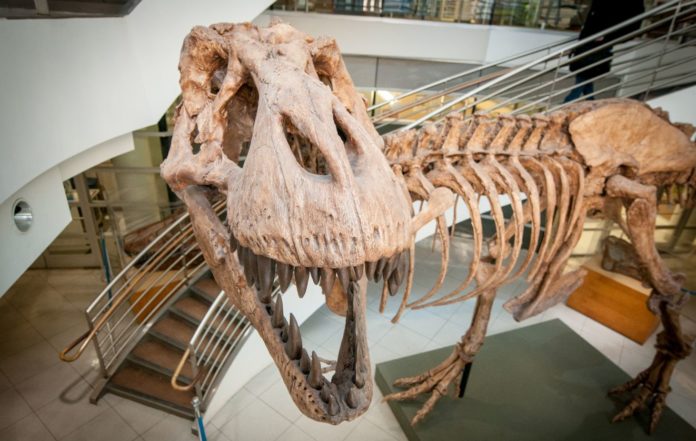But fewer than 100 have been dug up – many represented by a single fossilized bone.
The population was most likely 20,000 adults at one time, according to new research.
It is the first analysis of its kind into any long extinct animal.
- Neuroscience Breakthrough: Study Pinpoints Brain Activity That Helps Prevent Us From Getting Lost
- Brief Anger Hampers Blood Vessel Function Leading to Increased Risk of Heart Disease and Stroke – New Study
- New Blood Test Pinpoints Future Stroke Risk – Study Identifies Inflammatory Molecules as Key Biomarker
- Enceladus: A Potential Haven for Extraterrestrial Life in its Hidden Ocean Depths
- New Experiment: Dark Matter Is Not As ‘DARK’ As All We Think
Lead author Professor Charles Marshall, of the University of California, Berkeley, said: “The project just started off as a lark, in a way.
“When I hold a fossil in my hand, I can’t help wondering at the improbability this very beast was alive millions of years ago, and here I am holding part of its skeleton – it seems so improbable.
“The question just kept popping into my head, ‘Just how improbable is it? Is it one in a thousand, one in a million, one in a billion?’
“And then I began to realize that maybe we can actually estimate how many were alive, and thus, that I could answer that question.”
George Gaylord Simpson, one of the most influential paleontologists of the last century, felt it couldn’t be done.
T Rex had roamed for two-and-a-half million years when a city sized space rock crashed into the coast of Mexico – wiping out all non-avian dinosaurs.
Prof Marshall said: “As Simpson observed, it is very hard to make quantitative estimates with the fossil record.
“In our study, we focused on developing robust constraints on the variables we needed to make our calculations, rather than on focusing on making best estimates, per se.”
It was based on computer simulations covering a host of factors such as T Rex’s estimated sexual maturity of 15.5 years and a maximum lifespan of the late 20s.
Other factors included an adult body mass of up to seven tons thanks to a growth spurt in adolescence.
Prof Marshall chose to treat T Rex as a predator with energy requirements halfway between those of a lion and a Komodo dragon – the largest lizard on Earth.
It had a muscular body that stretched to 40 feet – as big as a school bus – and sharp teeth and jaws that could crush a car.
T Rex dominated the forested river valleys in western North America during the late Cretaceous.
The study, published in the journal Science, also found each generation lasted about 19 years – with an average density of one T Rex for every 62 square miles.
An expected geographic range of about 1.4 million square miles and a standing population of 20,000 means roughly 2.5 billion came into the world overall.
This was over the 127,000 generations that the species lived, reports prestigious journal Science.
It does not even include juvenile T Rex – which were almost like a different species. Prof Marshall ignored these.
They are under represented in the fossil record and may, in fact, have lived apart from adults and pursued other prey.
As T Rex crossed into maturity, its jaws became stronger by an order of magnitude, enabling it to crush bone.
With such a large number – not to mention the juveniles that were presumably more numerous – where did all those remains go?
Prof Marshall said: “There are about 32 relatively well-preserved, post-juvenile T Rexes in public museums today.
“Of all the post-juvenile adults that ever lived, this means we have about one in 80 million of them.
“If we restrict our analysis of the fossil recovery rate to where T Rex fossils are most common, a portion of the famous Hell Creek Formation in Montana, we estimate we have recovered about one in 16,000 of the T Rexes that lived in that region over that time interval that the rocks were deposited.
“We were surprised by this number; this fossil record has a much higher representation of the living than I first guessed.
“It could be as good as one in a 1,000, if hardly any lived there, or it could be as low as one in a quarter million, given the uncertainties in the estimated population densities of the beast.”
He believes his framework for estimating extinct populations can be applied to other fossilized creatures.
Prof Marshall said: “In some ways, this has been a palaeontological exercise in how much we can know, and how we go about knowing it.
“It is surprising how much we actually know about these dinosaurs and, from that, how much more we can compute.
“Our knowledge of T Rex has expanded so greatly in the past few decades thanks to more fossils, more ways of analyzing them, and better ways of integrating information over the multiple fossils known.”
The technique also lays the foundation for estimating how many species palaeontologists might have missed when excavating for fossils, he said.
- Neuroscience Breakthrough: Study Pinpoints Brain Activity That Helps Prevent Us From Getting Lost
- Brief Anger Hampers Blood Vessel Function Leading to Increased Risk of Heart Disease and Stroke – New Study
- New Blood Test Pinpoints Future Stroke Risk – Study Identifies Inflammatory Molecules as Key Biomarker
- Enceladus: A Potential Haven for Extraterrestrial Life in its Hidden Ocean Depths
- New Experiment: Dark Matter Is Not As ‘DARK’ As All We Think
Prof Marshall added: “With these numbers, we can start to estimate how many short-lived, geographically specialized species we might be missing in the fossil record.
“This may be a way of beginning to quantify what we don’t know.”
